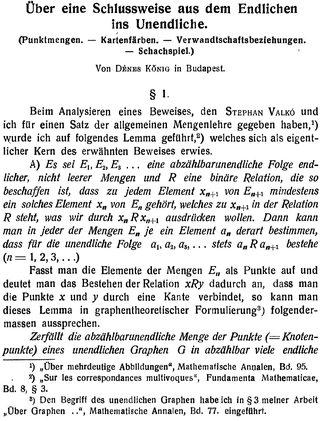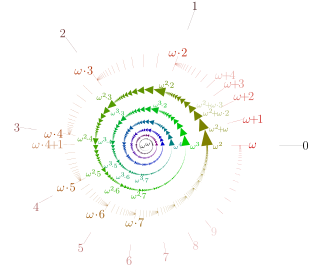
In mathematics, a cardinal number, or cardinal for short, is what is commonly called the number of elements of a set. In the case of a finite set, its cardinal number, or cardinality is therefore a natural number. For dealing with the case of infinite sets, the infinite cardinal numbers have been introduced, which are often denoted with the Hebrew letter (aleph) marked with subscript indicating their rank among the infinite cardinals.
In mathematics, an uncountable set, informally, is an infinite set that contains too many elements to be countable. The uncountability of a set is closely related to its cardinal number: a set is uncountable if its cardinal number is larger than aleph-null, the cardinality of the natural numbers.
In set theory, the axiom schema of replacement is a schema of axioms in Zermelo–Fraenkel set theory (ZF) that asserts that the image of any set under any definable mapping is also a set. It is necessary for the construction of certain infinite sets in ZF.
In the mathematical discipline of set theory, forcing is a technique for proving consistency and independence results. Intuitively, forcing can be thought of as a technique to expand the set theoretical universe to a larger universe by introducing a new "generic" object .

Kőnig's lemma or Kőnig's infinity lemma is a theorem in graph theory due to the Hungarian mathematician Dénes Kőnig who published it in 1927. It gives a sufficient condition for an infinite graph to have an infinitely long path. The computability aspects of this theorem have been thoroughly investigated by researchers in mathematical logic, especially in computability theory. This theorem also has important roles in constructive mathematics and proof theory.
An enumeration is a complete, ordered listing of all the items in a collection. The term is commonly used in mathematics and computer science to refer to a listing of all of the elements of a set. The precise requirements for an enumeration depend on the discipline of study and the context of a given problem.
In axiomatic set theory and the branches of mathematics and philosophy that use it, the axiom of infinity is one of the axioms of Zermelo–Fraenkel set theory. It guarantees the existence of at least one infinite set, namely a set containing the natural numbers. It was first published by Ernst Zermelo as part of his set theory in 1908.
In the mathematical discipline of set theory, 0# is the set of true formulae about indiscernibles and order-indiscernibles in the Gödel constructible universe. It is often encoded as a subset of the natural numbers, or as a subset of the hereditarily finite sets, or as a real number. Its existence is unprovable in ZFC, the standard form of axiomatic set theory, but follows from a suitable large cardinal axiom. It was first introduced as a set of formulae in Silver's 1966 thesis, later published as Silver (1971), where it was denoted by Σ, and rediscovered by Solovay, who considered it as a subset of the natural numbers and introduced the notation O#.

In mathematics, particularly in set theory, the aleph numbers are a sequence of numbers used to represent the cardinality of infinite sets that can be well-ordered. They were introduced by the mathematician Georg Cantor and are named after the symbol he used to denote them, the Hebrew letter aleph (ℵ).
Zermelo set theory, as set out in a seminal paper in 1908 by Ernst Zermelo, is the ancestor of modern Zermelo–Fraenkel set theory (ZF) and its extensions, such as von Neumann–Bernays–Gödel set theory (NBG). It bears certain differences from its descendants, which are not always understood, and are frequently misquoted. This article sets out the original axioms, with the original text and original numbering.
In set theory, a regular cardinal is a cardinal number that is equal to its own cofinality. More explicitly, this means that is a regular cardinal if and only if every unbounded subset has cardinality . Infinite well-ordered cardinals that are not regular are called singular cardinals. Finite cardinal numbers are typically not called regular or singular.
In mathematics, particularly in set theory, the beth numbers are a certain sequence of infinite cardinal numbers, conventionally written , where is the Hebrew letter beth. The beth numbers are related to the aleph numbers, but unless the generalized continuum hypothesis is true, there are numbers indexed by that are not indexed by .
In mathematics, the axiom of dependent choice, denoted by , is a weak form of the axiom of choice that is still sufficient to develop much of real analysis. It was introduced by Paul Bernays in a 1942 article that explores which set-theoretic axioms are needed to develop analysis.
In model theory, a branch of mathematical logic, the spectrum of a theory is given by the number of isomorphism classes of models in various cardinalities. More precisely, for any complete theory T in a language we write I(T, κ) for the number of models of T (up to isomorphism) of cardinality κ. The spectrum problem is to describe the possible behaviors of I(T, κ) as a function of κ. It has been almost completely solved for the case of a countable theory T.
Axiomatic constructive set theory is an approach to mathematical constructivism following the program of axiomatic set theory. The same first-order language with "" and "" of classical set theory is usually used, so this is not to be confused with a constructive types approach. On the other hand, some constructive theories are indeed motivated by their interpretability in type theories.

In set theory, the axiom of limitation of size was proposed by John von Neumann in his 1925 axiom system for sets and classes. It formalizes the limitation of size principle, which avoids the paradoxes encountered in earlier formulations of set theory by recognizing that some classes are too big to be sets. Von Neumann realized that the paradoxes are caused by permitting these big classes to be members of a class. A class that is a member of a class is a set; a class that is not a set is a proper class. Every class is a subclass of V, the class of all sets. The axiom of limitation of size says that a class is a set if and only if it is smaller than V—that is, there is no function mapping it onto V. Usually, this axiom is stated in the equivalent form: A class is a proper class if and only if there is a function that maps it onto V.
In proof theory, ordinal analysis assigns ordinals to mathematical theories as a measure of their strength. If theories have the same proof-theoretic ordinal they are often equiconsistent, and if one theory has a larger proof-theoretic ordinal than another it can often prove the consistency of the second theory.
In mathematics, the first uncountable ordinal, traditionally denoted by or sometimes by , is the smallest ordinal number that, considered as a set, is uncountable. It is the supremum of all countable ordinals. When considered as a set, the elements of are the countable ordinals, of which there are uncountably many.

In set theory, an ordinal number, or ordinal, is a generalization of ordinal numerals aimed to extend enumeration to infinite sets.
This is a glossary of set theory.






















































